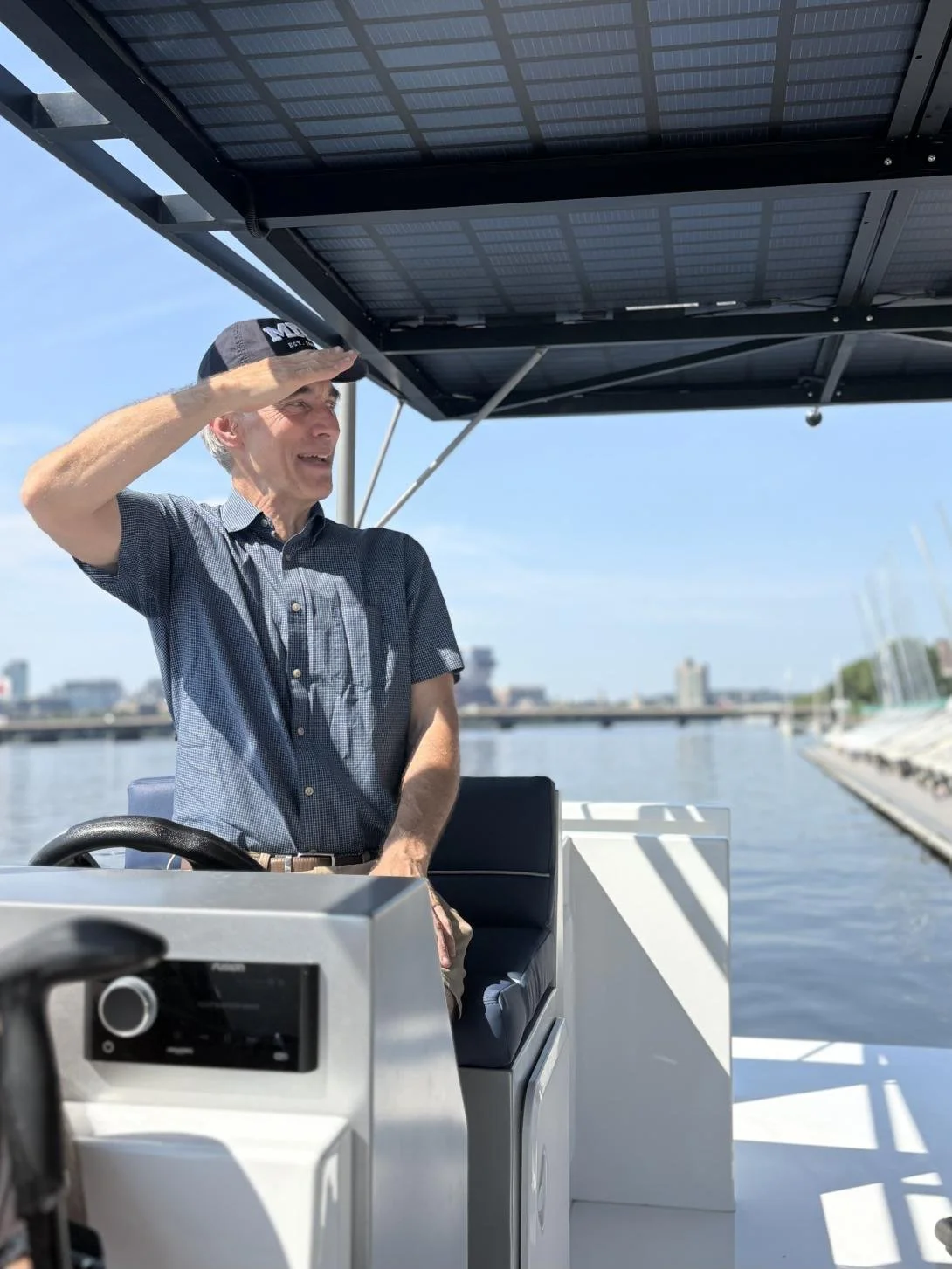Solar Powered Catamaran Makes a Splash at MIT Edgerton Center
Solar Electric Vehicle Team Founder James Worden '89 is sailing into the future of clean energy transportation
By: Jamie Chelel | August 5, 2025
The morning of July 30th was sweltering, but the dozen students from the Solar Electric Vehicle Team (SEVT) and the Edgerton Center gathered on the MIT sailing pavilion chatted with delight about the bright, sunny day. Docked beside them was a sleek, white catamaran with some unusual features, the most obvious of which is a dark gray roof extending across the length of the craft. Beyond providing a cool canopy of shade for those onboard, the roof - which is covered in solar panels - provides power for the entire vessel, including the built-in sound system.
Also unusual are the two propellers at the back of the boat, which are so low-profile, they could almost go unnoticed. The pair dip elegantly into the Charles River from slender gray fixtures, with no bulky engine in sight. The sides of the boat and the captain's chair are emblazoned with a cheerful logo featuring the sun beside the fledgling company’s name, Worden Marine.
Chatter on the dock hushed as James Worden ‘89 stepped to the helm and began speaking about his journey from founding SEVT in the ‘80s to his latest venture: founding Worden Marine in order to develop a series of novel solar-powered boats. The stylish vessel from which he spoke is the very first in the company’s fleet, called Anita in honor of Worden’s late wife and longtime collaborator, Anita Rajan Worden '90.
To the sun-soaked and eager crowd, Worden recounted some of the engineering challenges he and his team faced in their attempt to bring renewable energy to water level. There was the problem of aluminum sweat, solved by eschewing aluminum in favor of carbon fiber and high density structural foam core. Safety concerns related to all the electricity onboard were allayed with bespoke housing for the electronics, and using only the safest lithium ion batteries available. Balance and steering issues, which are common for super lightweight crafts, were successfully worked around with clever engineering to create a stable, safe craft.
Worden connected almost every challenge and solution back to the problem-solving and design skills he honed as founder of SEVT. He slipped frequent reminders to the students that they are also working on the cutting-edge of engineering, using many of the same technologies that Worden Marine employs to create their respective pioneering vehicles.
Then, it was time to see the solar boat in action. Visitors boarded in groups of six (the vessel can comfortably sit about 10), and settled into the cushioned bench seating lining either side of the craft. John Lagasse, the Engineering Manager at Worden Marine, gave those aboard a quick lesson in saluting (Lagasse is a US Air Force veteran), and unmoored the boat. Without a sound, the crew set off on the Charles River towards Boston.
Because it has no combustion engines, the vessel creates none of the noisy sputtering or rumbling typically associated with small boats. Thanks to its sleek and efficient design, it experiences minimal drag and creates practically no wake. As it sliced gracefully through the river at a speed of about 6 knots (flirting occasionally with the vehicle’s top speed of 10 knots), passengers enjoyed the gentle lapping of water on the hull and a pleasant hum of conversation.
In an “only at MIT” moment of serendipity, a miniature two-hulled, solar-powered robotic vessel glided up alongside the 20’ model and its occupants. From a nearby dinghy, the owner of the craft (deemed “Mini-Me” by Worden) shared excitedly that his device was fully autonomous and in its nascent stages of testing.
Next on the docket for Worden Marine is a 40’ ferry model, which will feature an innovative hull design and more bespoke electronics. The company aims to create a range of vehicles for a variety of audiences, all powered by renewable energy, and all with deep roots connecting back to MIT SEVT.
Navigating smoothly back towards the dock, Worden reflected about undertaking this project, “We approached this the same way Anita and I did everything. It’s passion. We believe in it.”

